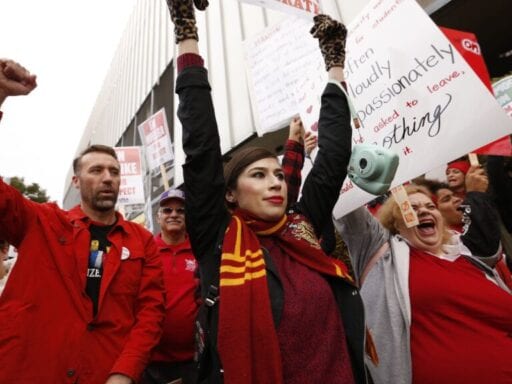Teachers would get a pay raise and smaller classes after their week-long strike.
Los Angeles public school teachers have reached a tentative deal with city leaders to end a strike that has shut down the nation’s second-largest school district for more than a week.
As part of the deal, teachers would get a 6 percent raise and slightly fewer students in each classroom, according to Alex Caputo-Pearl, president of United Teachers Los Angeles, a labor union that represents about 34,000 public school teachers, nurses, librarians, and support staff in the city.
“We have seen over the last week something pretty amazing happen,” Caputo-Pearl said at a press conference Tuesday morning at City Hall. “The creativity, innovation, passion, and love and emotion of our members was out on the street for everyone to see.” He was joined at the press conference by LA Mayor Eric Garcetti and District Superintendent Austin Beutner. The group said they reached a deal after an all-night negotiating session that ended at 6:15 am.
The deal includes hiring more nurses, guidance counselors, librarians, and support staff. The district will also try to limit the expansion of charters schools and will reevaluate testing requirements. Union members still need to vote on the contract before ending their strike, which has now lasted six days. If union and school board members ratify the contract, classes will resume on Wednesday and more than 600,000 students can return to school.
Randi Weingarten, president of the American Federation of Teachers, called the agreement a “paradigm shift.”
“For the first time in recent memory, the conversation has focused on how to fund our schools so students have the support they need,” Weingarten told me.
The deal follows a week of tense negotiating between teachers and school officials, who felt added pressure as the strike gained national — and even international — attention. Teachers pointed out that California is one of the wealthiest states in the country but ranks toward the bottom in how much money it invests per student. It’s unclear how much more money the state plans to funnel to its largest school district, but the strike certainly pushed local and state officials to hustle.
“The strike was painful and it had a cost, but it helped,” Garcetti said during Tuesday’s press conference.
The strike’s success adds new momentum to a national movement to boost investment in public education. Frustration over stagnant teacher wages, crumbling infrastructure, and deep budget cuts to education fueled a wave of teacher protests in conservative states in 2018. Educators went on strike in Arizona, West Virginia, Kentucky, and Oklahoma, forcing state lawmakers to raise their pay and spend more on schools.
The strike in Los Angeles suggests that the movement is expanding beyond the red states where it began, and could lead more progressive states to reexamine their investment in public education too.
The strike got school officials to move, fast
With 640,000 students, Los Angeles has the second-largest school district in the US (behind only New York City). Much of the student population is poor and underserved — about 80 percent of kids qualify for free or reduced-price lunch.
Yet California is among the states that spend the least on each student (adjusted for the cost of living), largely because of the state’s strict limits on property tax rates.
Union leaders and school district officials had spent more than a year negotiating a new contract but made little progress. Beutner, the school district’s superintendent, repeatedly blasted union leaders for trying “bankrupt” the city with its expensive proposals.
The teachers union has demanded a number of changes, including smaller class sizes; limited standardized testing; more support staff, such as nurses, librarians, and academic counselors; and a 6.5 percent salary increase. The union also wants the state to limit the expansion of public charter schools — privately run schools that receive state funding but are subject to fewer regulations.
Negotiations stalled even after teachers, nurses, and librarians voted in August to authorize a strike. It wasn’t until teachers walked out of class last week, shutting down every public school in the city, that talks began to move forward.
On Thursday, Gavin Newsom, California’s new Democratic governor, proposed a $209 billion budget that would increase school spending; school district officials also agreed to make some changes to classroom sizes and teacher salaries. Union leaders rejected the offer on Friday, calling it “woefully inadequate.”
After spending the weekend back at the negotiating table, there was a breakthrough.
On the surface, the deal appears to address most of the teachers’ concerns, though class sizes will only shrink by about four students — one each year for the next four years. The city’s middle and high school teachers currently have an average of 32 students in each classroom, double the national average.
During the press conference, Garcetti described the deal as “historic,” while the schools superintendent struck a more cautious tone. “We can’t solve 40 years of underinvestment in education in one week or one contract,” Beutner said.
Teachers and other union members are expected to vote Tuesday to approve the contract. If it fails, they go back to the table to strike another deal. If it passes, and the school board approves it, teachers will go back to work Wednesday.
Author: Alexia Fernández Campbell
Read More



